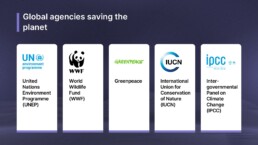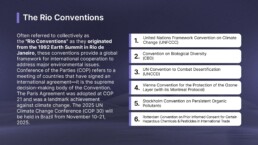The climate crisis isn’t some distant threat; it’s here, demanding urgent action. In this evolving reality, the tools of yesterday are no longer enough. We need bold, innovative solutions to chart a path forward—solutions like decarbonizing our atmosphere, conserving carbon sinks– forests and oceans and embracing cutting-edge practices like carbon sequestration. In this piece, we explore how modern solutions can address modern-day problems by working with nature. By leveraging nature’s strengths and infusing modern ingenuity, we can redefine what’s possible and secure a livable planet for generations to come. The time to act is now.
What is sustainability?
Sustainability is about ensuring our society can thrive today without jeopardizing the resources future generations will need.
“Meeting the needs of the present without compromising the ability of future generations to meet their own needs.” — The United Nations Brundtland Commission’s definition of sustainability in 1987
Why does sustainability matter?
Mitigating climate change
Climate change refers to long-term shifts in temperatures and weather patterns, primarily driven by human activities since the 1800s, such as the burning of fossil fuels. The resulting increase in GHG emissions is causing widespread environmental impacts, including polar melting, glacial retreat, thawing permafrost, and extreme weather events like floods and droughts. These changes lead to coastal erosion, the death and displacement of flora and fauna, wildfires, and the destruction of ecosystems. Human systems are equally affected, with crop destruction, loss of livelihoods, increased disease, and climate-induced migration, creating a cycle of escalating consequences.
Conserving natural resources
Minerals, forest products, water, and soil are just a few of the natural resources that we use to produce energy and are essential for our daily lives. Natural resources can be divided into two categories: renewable and nonrenewable. Renewable resources, like sunlight, air, and water, can be replenished and reused. But nonrenewable resources, such as fossil fuels (coal, oil, and gas), are limited and take millions of years to form. Burning these nonrenewable resources releases harmful GHGs like carbon dioxide. Without controlling these emissions, CO2 levels will rise. The result: Global warming and a rise in catastrophic events across the planet.
What will happen if we don’t live sustainably?
From Crisis to Cure: The Global Race to Save the Planet
Currently, the annual global carbon footprint is around 50 billion tons of CO2 equivalent emissions which means we have 8 years left until we spend our carbon budget if today’s levels of releasing emissions are kept. The solution to this problem is starting immediately with emissions reduction at a gradual pace and taking out the historically built-up CO2 from the atmosphere. As the effects of climate change intensify, countries and industries alike are seeking modern ways to meet emissions targets. Techniques like decarbonization and carbon sequestration show how we can work with nature to confront the climate crisis head-on.
Fundamentals of decarbonization
Decarbonization is a lifeline for a planet grappling with the weight of human-induced emissions. It’s not just good—it’s essential! By transitioning away from fossil fuels to renewable energy sources like solar, wind, and hydropower, we can fundamentally reshape our energy landscape. Decarbonization isn’t just about technology; it’s about systemic change. It requires a reimagining of economies, industries, and lifestyles. From rethinking how energy is generated to reinventing transportation systems and adopting regenerative land management practices, every aspect of how we live and work must evolve.
What is decarbonization?
Decarbonization refers to the process of reducing CO2 other GHG emissions from the atmosphere, resulting from human activities such as energy production and consumption. It involves transitioning from fossil fuels like coal, oil, and natural gas to cleaner, renewable energy sources such as solar, wind, and hydropower. It also encompasses improving energy efficiency, adopting sustainable practices in industry and transportation, and enhancing carbon capture and storage technologies. By lowering CO2 emissions, decarbonization plays a crucial role in mitigating climate change.
How is it beneficial?
The beauty of decarbonization lies in its dual impact—it protects the planet while unlocking new opportunities for innovation, economic growth, and equity. It calls for collective effort but promises shared rewards: cleaner air, resilient ecosystems, and a sustainable legacy for future generations.
Carbon sequestering: The science behind carbon sinks
Carbon sequestration is the capturing, removing, and permanently storing of CO2 from the earth’s atmosphere. But is it enough? Currently, about 45% of the CO2 emitted by human activities remains suspended in the atmosphere, driving global warming. Carbon sequestration is critical to reducing this dangerous buildup and preventing further emissions from contributing to the heating of the planet.
The importance of carbon sequestration lies in its ability to offset emissions that cannot be immediately eliminated. Nature has long been our ally in this effort through biological sequestration. Forests, grasslands, soils, and oceans act as vital “carbon sinks,” absorbing vast amounts of CO2 and helping to balance the global carbon cycle. However, these natural systems are under increasing strain due to deforestation, land degradation, and ocean acidification, which weaken their capacity to perform this critical function.
Geological sequestration offers a technological counterpart, storing CO2 deep underground in rock formations or other geological structures. Advances in artificial carbon-trapping methods are opening new doors. Direct air capture technology, for instance, removes CO2 directly from the air, while Carbon Capture and Storage (CCS) systems intercept emissions from industrial processes before they reach the atmosphere. They can then be compressed and transported to deep underground facilities, where they are injected into rock formations for permanent storage.
Despite these advancements, the scale of sequestration efforts remains far from adequate. As of February 2024, capture capacity that is either already in operation or has reached FID still accounts for just 20% of announced capture capacity for 2030 (Source: IEA). As of 2024, CCS was in operation at 44 plants worldwide, collectively capturing about one-thousandth of global carbon dioxide emissions. 90% of CCS operations involve the oil and gas industry.
CCS could have a critical but limited role in reducing greenhouse gas emissions. To meaningfully impact climate change, efforts must be ramped up exponentially. The biggest challenge is the pressing need for financial support mechanisms from national governments through international collaboration, apart from investment in research and infrastructure.
In the face of climate change, sustainability has shifted from a mere buzzword to a critical global necessity. With a heightened sense of urgency and the advent of new technologies, sustainability efforts are reshaping life in unprecedented ways. Understanding these evolving dynamics is crucial as we navigate the path toward a more sustainable future.






